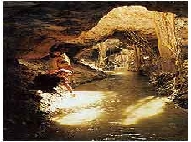 This refers to special wells that are linked by underground tunnels and provide irrigation in the desert. This method of irrigation was passed on to Xinjiang people during the Western Han Dynasty (206 B.C. – A.D. 24). The wells were sunk at varying distances to a dozen or several dozen meters deep to collect undercurrent water from melting snow. The water is then channeled through tunnels dug from the bottom of one well to the next and led to oases for irrigation. Most of such irrigation tunnels stretch for some three kilometers, but some extend as far as thirty kilometers. There are about 1,100 such wells in the area embracing Hami and the Turpan Depression. Today, the total length of such underground irrigation tunnels in Xinjiang runs for three thousand kilometers. The project can well be compared with the Great Wall and the Grand Canal. The world-famous grapes of Xinjiang owe their excellence to the existence of these wells. This refers to special wells that are linked by underground tunnels and provide irrigation in the desert. This method of irrigation was passed on to Xinjiang people during the Western Han Dynasty (206 B.C. – A.D. 24). The wells were sunk at varying distances to a dozen or several dozen meters deep to collect undercurrent water from melting snow. The water is then channeled through tunnels dug from the bottom of one well to the next and led to oases for irrigation. Most of such irrigation tunnels stretch for some three kilometers, but some extend as far as thirty kilometers. There are about 1,100 such wells in the area embracing Hami and the Turpan Depression. Today, the total length of such underground irrigation tunnels in Xinjiang runs for three thousand kilometers. The project can well be compared with the Great Wall and the Grand Canal. The world-famous grapes of Xinjiang owe their excellence to the existence of these wells.
|